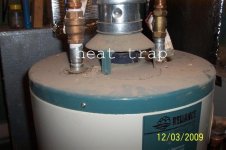Travelover
Elite Member
My current gas water heater is 20 years old and I can see the handwriting on the wall, so I bought a new heater. Since 20 years have gone by, I have a few questions about installing it.
First question: My old water heater has the rotten egg smell problem associated with well water, so I took the anode out and tossed it. The instructions for the new heater say to use a different kind of anode as opposed to just removing it. Anyone have experience there? Obviously I'd prefer to just remove this one and the tank life seems to be OK with out it.
Second question: I have the old heater plumbed with a hot water return line from the far end of the house to the drain valve. This allows water to circulate from convection, giving me hot water fast anywhere in the house. It has worked great for 20 years. Do these new conventional water heaters have some internal valving to prevent me from plumbing the new heater the same way?
First question: My old water heater has the rotten egg smell problem associated with well water, so I took the anode out and tossed it. The instructions for the new heater say to use a different kind of anode as opposed to just removing it. Anyone have experience there? Obviously I'd prefer to just remove this one and the tank life seems to be OK with out it.
Second question: I have the old heater plumbed with a hot water return line from the far end of the house to the drain valve. This allows water to circulate from convection, giving me hot water fast anywhere in the house. It has worked great for 20 years. Do these new conventional water heaters have some internal valving to prevent me from plumbing the new heater the same way?
